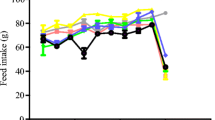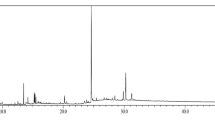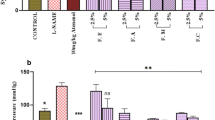Abstract
This study investigated the in vitro effect of various combinations of aqueous extracts of moringa (Moringa oleifera) leaves on the ACE inhibitory and antioxidant properties of lisinopril, which is a popular synthetic ACE inhibitor. Moringa leaves were air-dried and blended into powdery form. Thereafter, the aqueous extract was prepared and freeze-dried. The following sample mixtures were prepared: L = 100% lisinopril (1 mg/ml); M = 100% moringa extract (1 mg/ml); 1L + 3M = 25% lisinopril + 75% moringa extract; L + M = 50% lisinopril + 50% moringa extract; 3L + 1M = 75% lisinopril + 25% moringa extract. The results revealed that 100% moringa and the various combinations showed higher ACE inhibition than 100% lisinopril in both rat heart and lung homogenates. Furthermore, all the samples caused the inhibition of Fe2+-induced lipid peroxidation in rat heart and lung tissue homogenates, with moringa leaf extract having the highest inhibitory ability. All the samples also showed antioxidant properties (ferric reducing antioxidant property, 2,2’-azino-bis (-3-ethylbenzthiazoline-6-sulphonate [ABTS*] and 1,1-diphenyl-2-picrylhydrazyl [DPPH] free radicals scavenging abilities, and Fe2+ chelating ability). This study revealed that moringa leaf extracts could improve the antioxidant and ACE inhibitory properties of lisinopril. However, further in vivo experiments and clinical trials are recommended.








Similar content being viewed by others
References
Adefegha SA, Oboh G, Oyeleye SI, Dada FA, Ejakpovi I, Boligon AA (2017) Cognitive enhancing and antioxidative potentials of velvet beans (Mucuna pruriens) and horseradish (Moringa oleifera) seeds extract: a comparative study. J Food Biochem 41:1–11
Belle N, Dalmolin G, Fonini G, Rubim M, Rocha JBT (2004) Polyamines reduces lipid peroxidation induced by different pro-oxidant agents. Brain Res 1008:245–251
Bourne L, Rice-Evans C (1998) Bioavailablity of ferulic acid. Biochem Biophy Res Comm 253:222–227
Breitinger H (2012) Drug synergy—mechanisms and methods of analysis, toxicity and drug testing. InTech http://www.intechopen.com/books/toxicity-and-drug-testing/drug-synergy-mechanisms-and-methods-ofanalysis
Chopra M, Beswick H, Clapperton M, Dargie HJ, Smith WE, McMurray J (1992) Antioxidant effects of angiotensin-converting enzyme (ACE) inhibitors: free radical and oxidant scavenging are sulfhydryl dependent, but lipid peroxidation is inhibited by both sulfhydryl and nonsulfhydryl-containing ACE inhibitors. J Cardiovasc Pharmacol 19:330–340
Cushman DW, Cheung HS (1971) Spectrophotometric assay and properties of the angiotensin I converting enzyme of rabbit lung. Biochem Pharmacol 20:1637–1648
Dastmalchi K, Dorman HJD, Kosar M, Hiltunen R (2007) Chemical composition and in vitro antioxidant evaluation of a water soluble Moldavian balm (Dracocephalum moldavica L) extract. Lebensm Wiss Technol 40:239–248
Erdos EG, Skidgel RA (1987) The angiotensin I-converting enzyme. Lab Invest 56:345–348
Evangelista S, Manzini S (2005) Antioxidant and cardioprotective properties of the sulphydryl angiotensin converting enzyme inhibitor zofenopril. J I Med Res 33:42–54
Guerrero L, Castillo J, Quiñones M, Garcia-Vallvé S, Arola L, Pujadas G, Muguerza B (2012) Inhibition of angiotensin-converting enzyme activity by flavonoids: structure–activity relationship studies. PLoS ONE 7:49493
Gyamfi MA, Yonamine M, Aniya Y (1999) Free-radical scavenging action of medicinal herbs from Ghana: Thonningia sanguinea on experimentally induced liver injuries. Gen Pharmacol 32:661–667
Kirbas S, Kutluhan S, Kirbas A, Sutcu R, Kocak A, Uzar E (2013) Effect of lisinopril on oxidative stress in brain tissues of rats with L-Name induced hypertension. Turk J Biochem 38(2):163–168
Meda A, Lamien CE, Romito M, Millogo J, Nacoulma OG (2005) Determination of the total phenolic, flavonoid and proline contents in Burkina Faso honey, as well as their radical scavenging activity. Food Chem 91:571–577
Minotti G, Aust SD (1987) An investigation into the mechanism of citrate-Fe2+-dependent lipid peroxidation. Free Rad Biol Med 3:379–387
Mira ML, Silva MM, Queiroz MJ, Manso CF (1993) Angiotensin converting enzyme inhibitors as oxygen free radical scavengers. Free Rad Res Comm 19(3):173–181
Oboh G, Ademosun AO (2011) Shaddock peels (Citrus maxima) phenolic extracts inhibit a-amylase, a-glucosidase and angiotensin I-converting enzyme activities: a nutraceutical approach to diabetes management. Diab Metabol Synd Clin Res Rev 5(3):148–152
Oboh G, Rocha JBT (2007) Polyphenols in red pepper [Capsicum annuum var aviculare (tepin)] and their protective effect on some pro-oxidants induced lipid peroxidation in brain and liver. Eur Food Res Technol 225:239–247
Oboh G, Ademiluyi AO, Ademosun AO, Olasehinde TA, Oyeleye SI, Boligon AA, Athayde ML (2015) Phenolic extract from Moringa oleifera leaves inhibits key enzymes linked to erectile dysfunction and oxidative stress in rats’ penile tissues. Biochem Res Int Article ID 175950
Oboh G, Ogunsuyi OB, Ogunbadejo MD, Adefegha SA (2016) Influence of gallic acid on α-amylase and α-glucosidase inhibitory properties of acarbose. J Food Drug Anal 24(3):627–634. https://doi.org/10.1016/j.jfda.2016.03.003
Ohkawa H, Ohishi N, Yagi K (1979) Assay for lipid peroxides in animal tissues by thiobarbituric acid reaction. Ann Rev Biochem 95:351–358
Oyaizu M (1986) Studies on products of browning reaction: antioxidative activity of products of browning reaction prepared from glucosamine. Jpn J Nutr 44:307–315
Puntel RL, Nogueira CW, Rocha JBT (2005) Krebs cycle intermediates modulate thiobarbituric reactive species (TBARS) production in rat brain In vitro. Neurochem Res 30:225–235
Re R, Pellegrini N, Proteggente A, Pannala A, Yang M, Rice-Evans C (1999) Antioxidant activity applying an improved ABTS radical cation decolorisation assay. Free Rad Biol Med 26:1231–1237
Rodriguez-Rodriguez R, Simonsen U (2012) Measurement of nitric oxide and reactive oxygen species in the vascular wall. Curr Anal Chem 8:1–10
Singleton VL, Orthofor R, Lamuela-Raventos RM (1999) Analysis of total phenols and other oxidation substrates and antioxidants by means of Folin–Ciocaltau reagent. Method Enzymol 299:152–178
Sprague AH, Khalil RA (2009) Inflammatory cytokines in vascular dysfunction and vascular disease. Biochem Pharmacol 78(6):539–552
Stohs SJ, Hartman MJ (2015) Review of the safety and efficacy of Moringa oleifera. Phytother Res 29(6):796–804. https://doi.org/10.1002/ptr.5325
Virdis A, Duranti E, Taddei S (2011) Oxidative stress and vascular dam-age in hypertension: role of angiotensin II. Int J Hypertens. https://doi.org/10.4061/2011/916310
Zar JH (1984) Biostatistical analysis. Prentice Hall, Englewood Cliffs, p 620
Acknowledgements
The authors would like to thank Dr. S. A. Adefegha for his advice and encouragement during the drafting of the manuscript.
Author information
Authors and Affiliations
Corresponding author
Ethics declarations
Ethical statement
The handling and use of the animals were in accordance with the National Institutes for Health Guide for the Care and Use of Laboratory Animals. The handling and use of the experimental animals was as approved by the Animal Ethics Committee of the School of Sciences, Federal University of Technology, Akure, Nigeria, with protocol reference SOS/14/02a.
Conflict of interest
The authors declare no conflict of interests.
Rights and permissions
About this article
Cite this article
Oboh, G., Ademosun, A.O., Oyetomi, O.J. et al. Influence of Moringa (Moringa oleifera) leaf extracts on the antioxidant and angiotensin-1 converting enzyme inhibitory properties of lisinopril. Orient Pharm Exp Med 18, 317–324 (2018). https://doi.org/10.1007/s13596-018-0317-y
Received:
Accepted:
Published:
Issue Date:
DOI: https://doi.org/10.1007/s13596-018-0317-y




